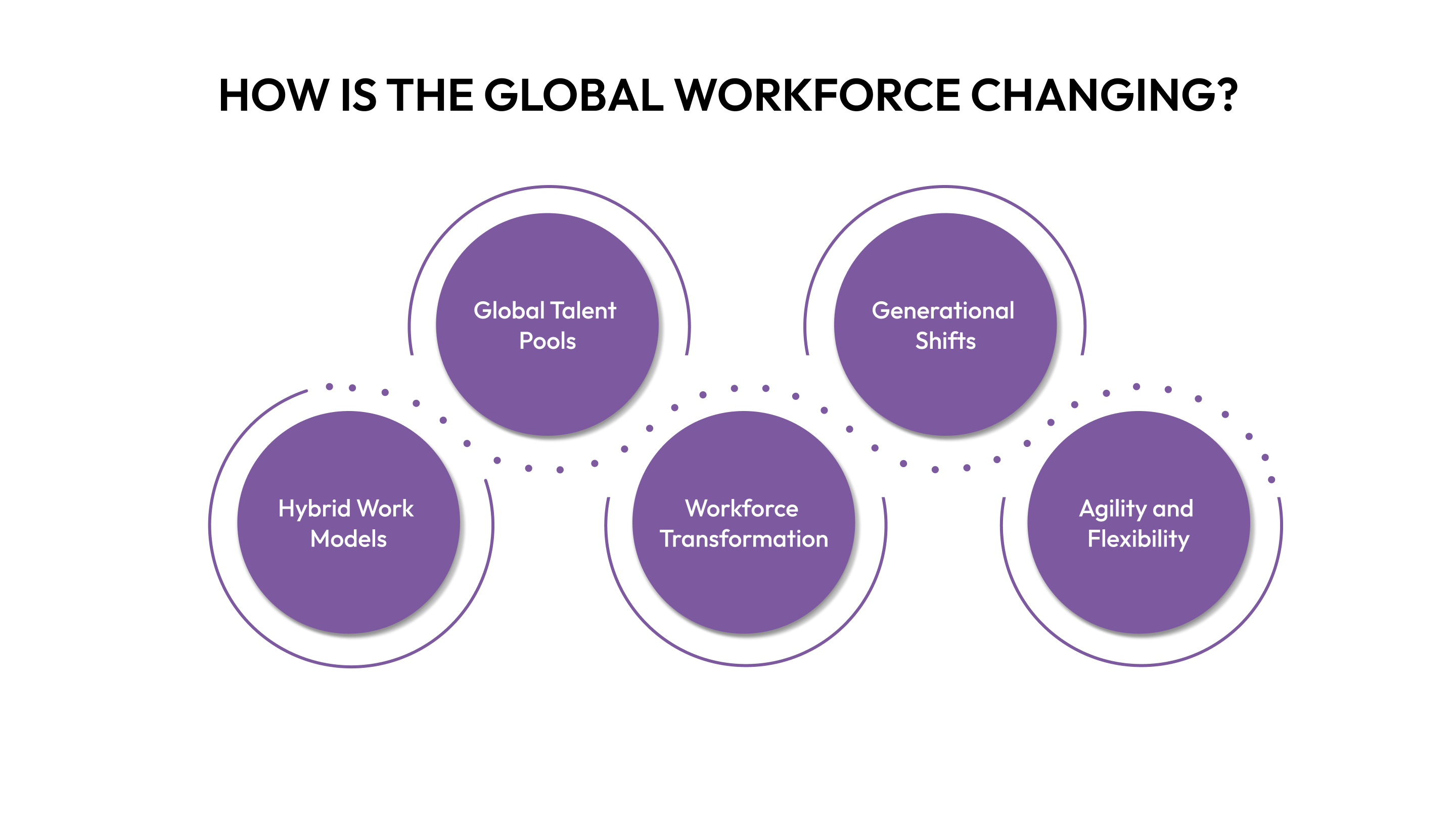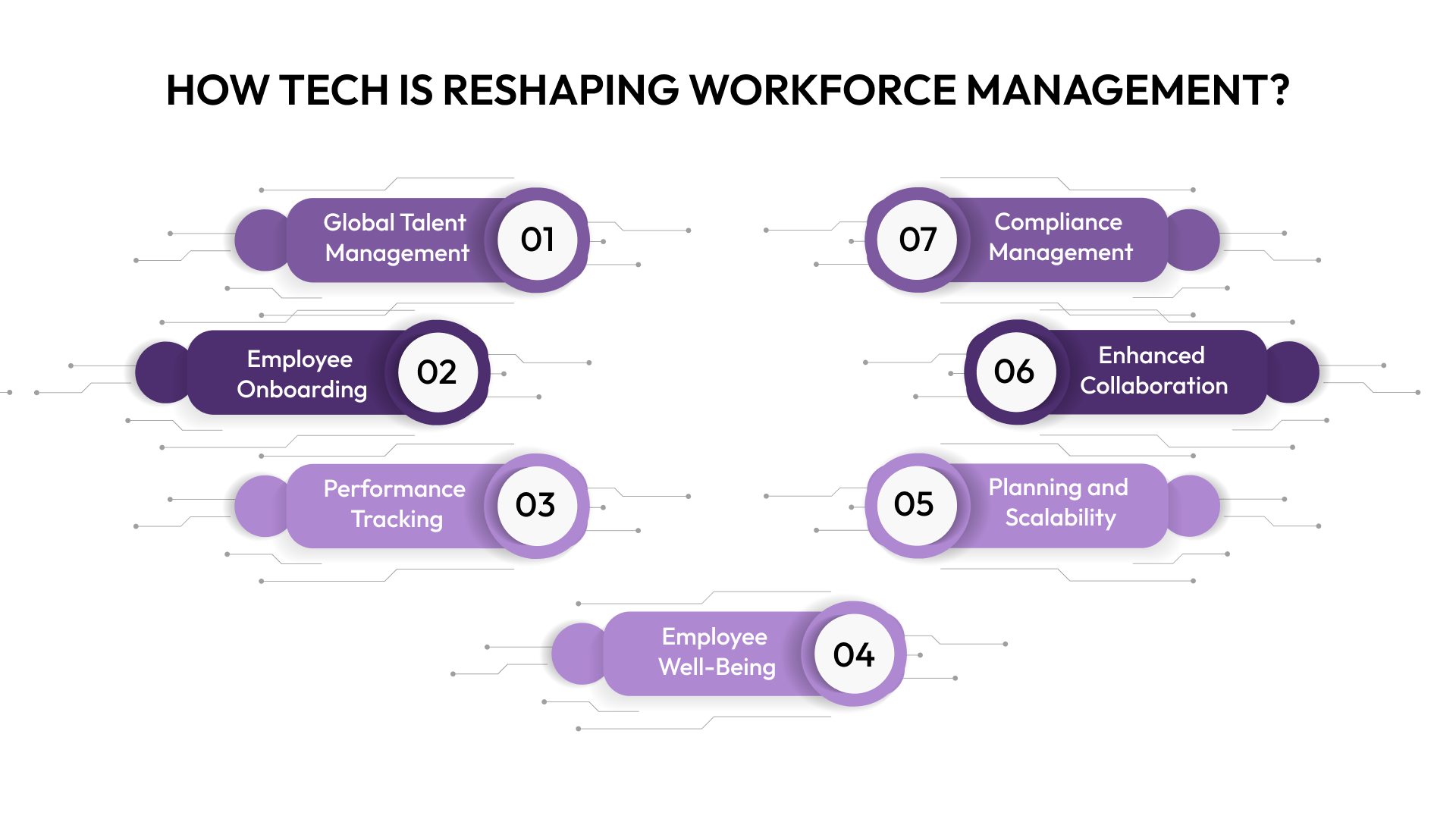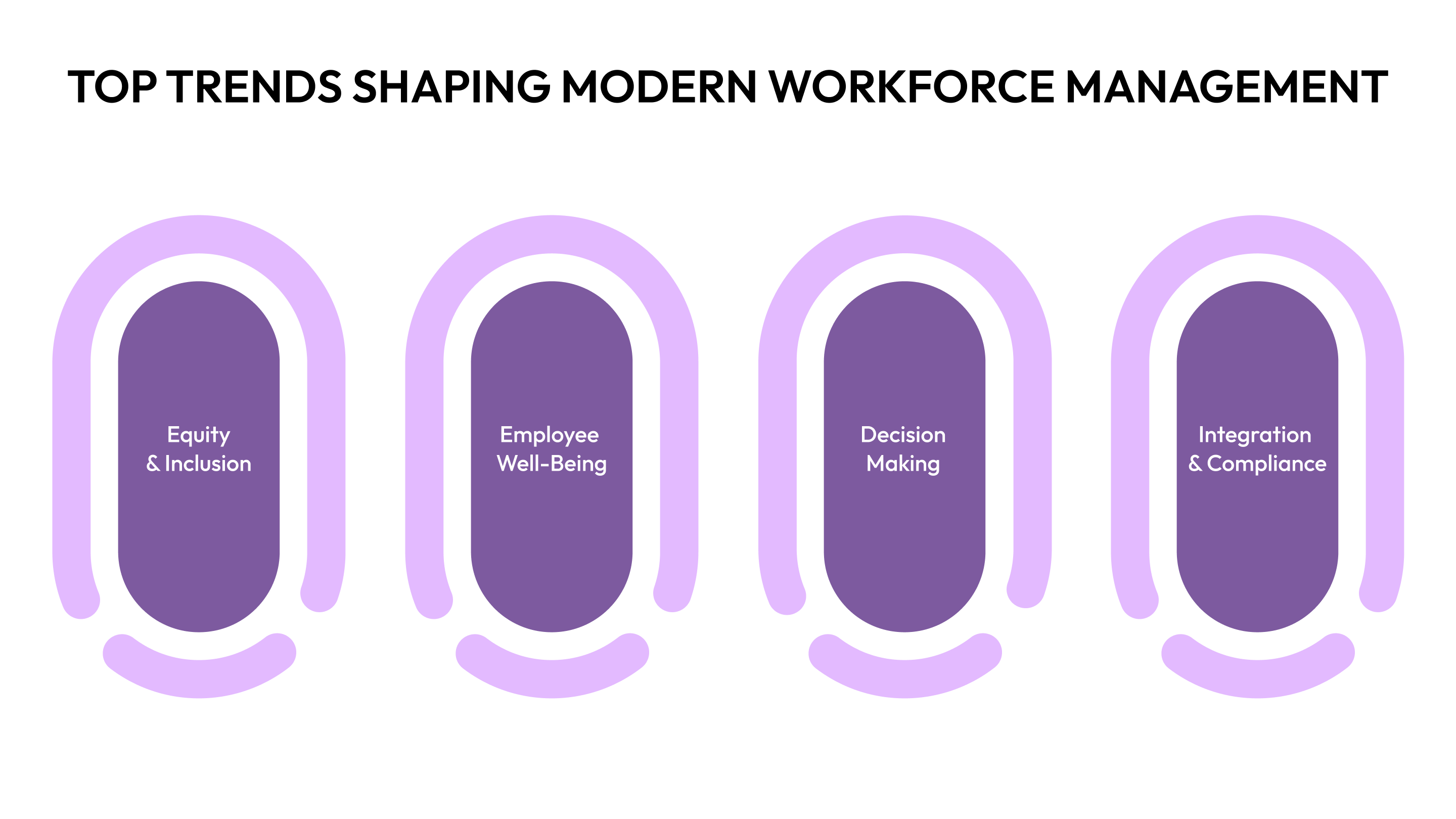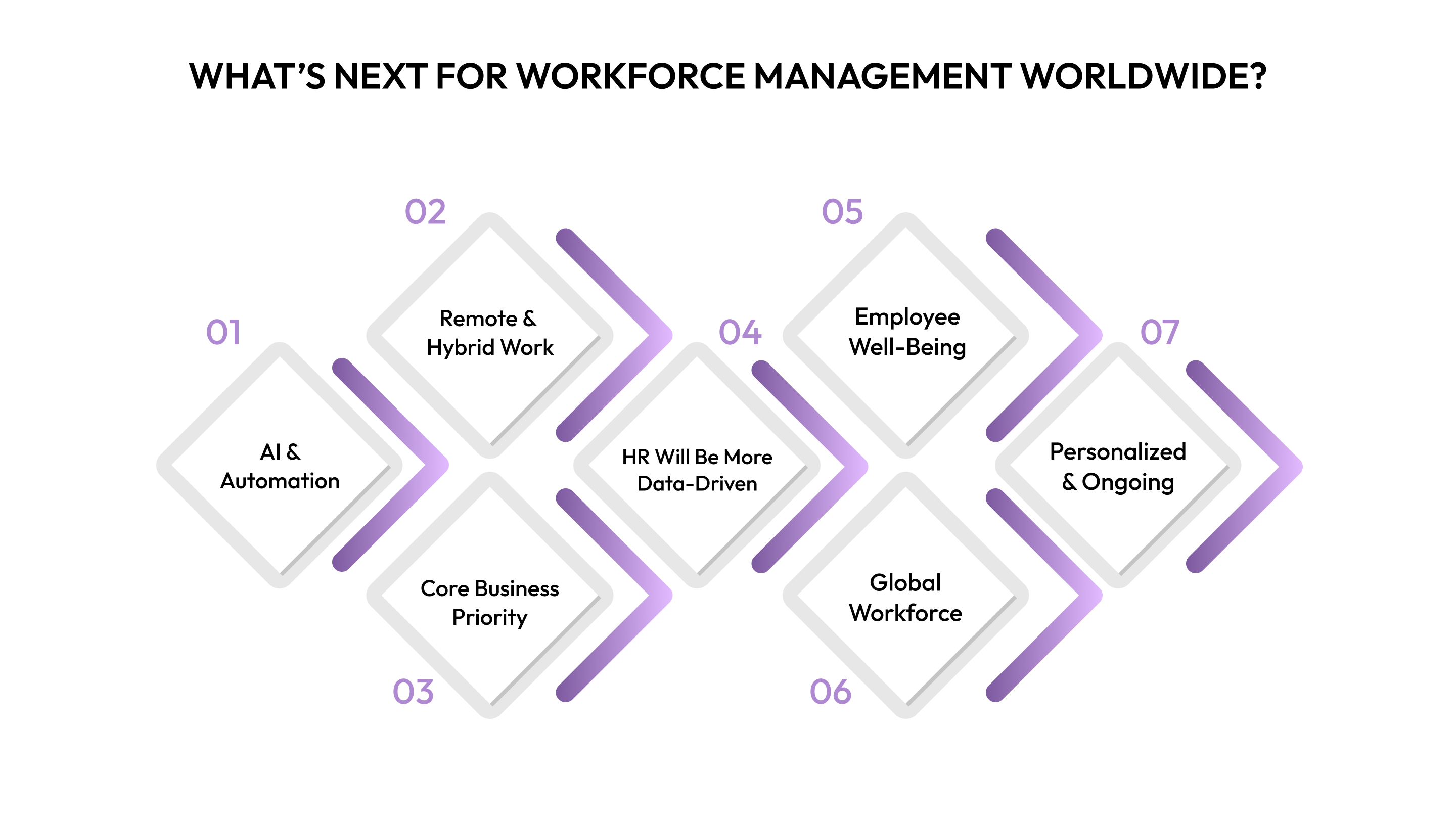AI and the New Era of Workforce Management
Discover how AI HR startups are transforming workforce management with smarter, ethical, and scalable solutions for a global workforce.

The way we manage workforces is changing, and artificial intelligence is leading the way. With businesses under constant pressure to stay competitive and innovative, we understand how challenging it can be for HR teams to balance efficiency, fairness, and employee satisfaction all at once.
AI is giving HR teams smarter tools to handle talent more efficiently, fairly, and effectively. From hiring and performance tracking to employee engagement, AI is touching every part of workforce management.
It’s not just about automating tasks, but about making smarter decisions, enhancing productivity, and creating a more inclusive environment. As AI continues to evolve, it promises to transform how we approach workforce challenges and opportunities.
In this blog, you'll explore how AI is transforming workforce management and learn strategies that help organizations grow in this new era of work.
Key Takeaways:
- Remote and hybrid work connect global talent with flexible setups.
- Diverse, multi-generational teams need inclusive hiring and tailored experiences.
- AI, automation, and cloud tools streamline recruitment, onboarding, and performance management.
- Focus on employee well-being, DEI, and continuous learning to build a high-performing workplace.
- Data-driven insights and collaboration tools enhance engagement, retention, and productivity.
How is the Global Workforce Changing?

The way we work is changing fast. Globalization, rapid tech advancements, and evolving employee expectations are reshaping today’s workforce in a big way. Keeping up with these shifts is key to staying ahead and building a team that’s ready for what’s next.
As businesses scale, HR teams are navigating both the challenges and opportunities that come with managing a more diverse workforce that spans multiple generations and is often spread across different locations.
Let’s break down some of the major trends driving this change in global workforce management:
Rise of Remote and Hybrid Work Models
The shift to remote work took off during the pandemic, and now, hybrid work models, mixing in-office and remote setups, are here to stay. For many businesses, this change has opened the door to global talent. This allows them to hire based on skills, not just location, while giving employees the flexibility they value.
Some key impacts on HR include:
- Engaging candidates, onboarding new hires, and supporting employees across time zones calls for fresh thinking and smarter processes.
- Keeping people connected, engaged, and aligned, no matter where they work, is now a top priority.
- HR teams need tools and systems that make collaboration smooth and support flexible, productive work across the board.
Global Talent Pools and Diversity
Hiring across borders has become easier than ever, and with it comes a workforce that’s more diverse in culture, background, and experience. For HR, this is both a huge opportunity and a responsibility to build workplaces where everyone feels included and supported.
Some key impacts on HR include:
- HR teams must navigate different work styles, communication preferences, and cultural norms.
- It’s important to encourage a culture where diverse perspectives are valued and collaboration is encouraged across teams and regions.
- Inclusive hiring practices and employee support systems are no longer optional; they’re essential for building a strong, global culture.
Technology-Driven Workforce Transformation
AI, automation, and machine learning are reshaping how work gets done, from recruitment and onboarding to performance tracking and workforce planning. These tools aren’t just making processes faster; they’re helping HR become more strategic and data-driven.
Some key impacts on HR include:
- Routine tasks like payroll, leave tracking, and data entry can now be automated, saving time and reducing manual errors.
- AI-powered platforms are helping HR make smarter decisions around employee growth, engagement, and retention. CandorIQ is helping HR teams consolidate workforce data and use AI to simplify talent management, learning, and development processes.
- As tech becomes more central to HR, upskilling employees and ensuring smooth tech integration are critical to long-term success.
Generational Shifts in the Workforce
With baby boomers, Gen X, millennials, and Gen Z all working together, today's workforce is more age-diverse than ever. Each group has its own expectations, especially when it comes to flexibility, career paths, and work culture.
Some key impacts on HR include:
- Understanding what drives each generation helps HR teams shape better employee experiences.
- Younger employees often prioritize flexibility, career development, and digital-first workplaces.
- HR strategies, whether for training, benefits, or engagement, need to reflect these generational needs without losing sight of the bigger picture.
Agility and Flexibility in Workforce Management
Today, agility is necessary. Businesses should adapt quickly to shifting market demands, evolving employee needs, and unexpected disruptions.
Key impacts on HR include:
- Agile HR means being able to scale teams, shift roles, or roll out new policies quickly and efficiently.
- Practices like flexible work hours, project-based teams, and real-time feedback help keep people engaged and aligned.
- Balancing personalized employee support with organizational flexibility is key to building a workforce that’s ready for whatever comes next.
As the workforce is becoming more diverse, distributed, and effective, the way organizations manage people is also evolving. That’s where technology is stepping in.

Also Read: Key Considerations for Workforce Management Dashboards
How Tech is Reshaping Workforce Management

Today, technology plays a key role in how companies manage and support their global workforce. With remote work on the rise, teams spread across time zones, and growing access to global talent, HR professionals need the right tools to stay agile and competitive.
It’s about making smarter decisions, simplifying processes, and building a more connected, engaged workforce. Let’s take a closer look at how technology is reshaping global workforce management:
Global Talent Management and Recruitment
Technology has opened up hiring on a global scale, helping companies find the right talent no matter where they are. AI-powered tools are now playing a major role in screening resumes, matching candidates, and predicting job success, making the recruitment process faster and more accurate.
Here’s what this means for HR:
- AI-enabled Applicant Tracking Systems (ATS) can rank candidates based on skills, experience, and fit, cutting down on manual review time.
- Global sourcing platforms help HR teams tap into diverse talent pools across regions, leading to more inclusive hiring.
- With the right tech, HR can maintain consistent hiring standards across locations and reduce bias in decision-making.
Improved Employee Onboarding and Engagement
Gone are the days of paper-heavy onboarding. Today, cloud-based tools and AI chatbots are making the process smoother, more interactive, and accessible from anywhere, especially important for remote teams.
Here’s what this means for HR:
- Centralized onboarding platforms make it easy for new hires to access documents, policies, and resources in one place.
- AI chatbots guide new employees through the process, answer FAQs, and offer real-time support.
- Digital learning tools allow employees to complete training at their own pace, improving engagement while cutting down on costs.
Real-Time Employee Performance Tracking
As remote and hybrid work models become the norm, HR needs better ways to monitor performance and support growth, regardless of where employees work. Tech-driven performance tools are helping track goals, provide feedback, and identify trends in real time.
Here’s what this means for HR:
- Performance platforms let managers set clear goals, track progress, and give ongoing feedback, no matter the location.
- Analytics can highlight high performers, flag areas for improvement, and even detect early signs of burnout.
- Gamified tools make feedback more engaging, encouraging continuous learning and development.
Employee Well-Being and Support
With distributed teams, employee well-being is front and center. From monitoring sentiment to delivering personalized wellness plans, tech is helping HR support employees in smarter, more proactive ways.
Here’s what this means for HR:
- Real-time sentiment analysis helps HR spot issues early and respond before they escalate.
- AI-powered wellness tools offer tips on managing stress, work-life balance, and productivity, based on real-time insights.
- Tech-enabled Employee Assistance Programs (EAPs) provide easy access to mental health and support resources, anytime.
Agile Workforce Planning and Scalability
In a fast-moving business environment, being able to scale and adapt quickly is critical. With AI and cloud-based platforms, HR can now plan, forecast, and reallocate resources with greater speed and accuracy.
Here’s what this means for HR:
- Predictive analytics helps HR forecast talent needs, spot skill gaps, and plan ahead for hiring.
- Cloud-based planning tools offer real-time views into team capacity, resource use, and workforce costs.
- Effective workforce models allow HR to quickly respond to shifting market needs or organizational changes.
Enhanced Collaboration and Communication
For teams spread across cities or continents, smooth communication is a must. Tech tools, from video calls to shared dashboards, make it easy for employees to stay connected, aligned, and productive.
Here’s what this means for HR:
- Platforms like Slack, Teams, or Zoom help global teams stay in sync and collaborate effectively.
- Project management tools like Asana or Trello bring transparency and accountability to team workflows.
- AI meeting assistants can handle scheduling, reminders, and even transcribe discussions, saving time and keeping everyone on track.
Global Compliance Management
Navigating compliance across multiple countries can be complex, but the right tools simplify the process. Technology helps HR teams stay on top of local regulations and ensure company policies are up to date everywhere they operate.
Here’s what this means for HR:
- Compliance platforms track regional labor laws, safety guidelines, and tax regulations automatically.
- Automated reports minimize the risk of errors and keep records organized and accessible.
- HR can adapt more quickly to policy changes and stay audit-ready, lowering legal and regulatory risks.
As technology is playing a bigger role in how teams are managed and supported, certain trends are starting to stand out.
Top Trends Shaping Modern Workforce Management

Workforce management is changing fast and is driven by new technologies, shifting employee expectations, and the growing influence of global talent. For HR leaders and forward-thinking organizations, staying on top of these changes is essential to building a resilient, future-ready workforce.
Let’s take a closer look at the key trends shaping the way we manage people today:
Diversity, Equity, and Inclusion (DEI) Initiatives
Building a diverse and inclusive workforce is crucial for business success. Today’s HR teams are leading the charge in creating environments where people from all backgrounds feel seen, supported, and empowered to grow.
Here’s what this means for HR:
- AI tools reduce bias in hiring and performance reviews, helping create fairer outcomes.
- More companies are investing in diverse leadership, inclusive policies, and training programs like unconscious bias workshops.
- The goal is to move beyond surface-level diversity and build a truly inclusive culture that lasts.
Employee Well-Being and Mental Health Initiatives
Employee well-being has taken center stage, especially after the pandemic. Today’s HR teams are focusing on holistic wellness programs that go beyond physical health to include mental, emotional, and even financial well-being.
Here’s what this means for HR:
- Real-time sentiment analysis helps HR catch signs of burnout or disengagement early.
- AI-powered wellness tools can monitor stress levels, suggest better work habits, and guide employees to helpful resources.
- Tech-enabled Employee Assistance Programs (EAPs) ensure that support is just a click away, anytime, anywhere.
Data-Driven Decision Making
HR is no longer just about instincts and experience; data is playing a bigger role than ever. From hiring to retention to engagement, smart analytics are helping teams make better, faster, and more strategic decisions.
Here’s what this means for HR:
- Predictive tools can flag potential attrition risks, allowing HR to act before employees walk out the door.
- Performance data shows where training is needed and whether development efforts are paying off.
- Real-time engagement tracking lets HR respond quickly to dips in morale or motivation.
Global Workforce Integration and Compliance
As businesses expand across borders, managing a global workforce comes with added complexity. HR must ensure employees in different regions are treated fairly and that the company stays compliant with local labor laws.
Here’s what this means for HR:
- Cloud-based HR platforms help track compliance across countries and regions in one centralized system.
- Automated tools reduce manual errors and keep compliance records secure and up to date.
- When laws or regulations change, technology helps HR respond quickly, minimizing risk and keeping operations smooth.
As these trends continue to shape the way organizations operate, businesses are rethinking their workforce strategies to stay agile and competitive.
You Might Also Like: The Complete Guide to Employee Compensation and Benefits
Smart Workforce Strategies for a Global World

As companies expand across borders, managing a workforce that spans different cultures, time zones, and tech environments is becoming more challenging. To grow in this evolving landscape, HR teams need forward-thinking workforce management practices that are flexible, scalable, and built with inclusivity in mind.
Let’s explore some of the most innovative practices that are reshaping global HR operations today:
Build a Global Talent Ecosystem
Today’s businesses aren’t limited by geography when it comes to hiring. More organizations are tapping into global talent pools, creating networks of freelancers, remote employees, and distributed teams to meet changing needs. For that:
- Use AI-powered recruitment tools to source and evaluate talent from anywhere in the world.
- Offer flexible contracts, such as freelance, part-time, or project-based, to scale talent based on real-time demand.
A global workforce brings in fresh ideas and diverse perspectives. It also allows businesses to adapt quickly and scale faster without being tied to a single location.
Embrace Agile Talent Management
Business priorities shift fast, and HR teams need to keep up. Agile talent management facilitates rapid decision-making, particularly when collaborating with global teams across diverse markets. For that:
- Build cross-functional, remote teams that tackle short-term, high-impact projects.
- Use continuous feedback tools and performance platforms that align with evolving goals.
Agility helps organizations stay responsive to change while empowering teams to innovate, iterate, and deliver faster results.
Create Personalized Employee Experiences
With a more diverse workforce, a one-size-fits-all approach doesn’t cut it anymore. Personalization is becoming essential in how companies engage, develop, and retain their people. For that:
- Use AI and analytics to tailor learning paths, career development, and even compensation packages.
- Offer self-service tools that allow employees to personalize their schedules, benefits, and development resources.
When employees feel seen and supported as individuals, engagement and retention naturally improve, and so does performance.
Use Data to Drive Better Decisions
Data is giving HR teams sharper insights into what works and what doesn’t, helping them plan smarter and act faster. For that:
- Use predictive analytics to spot turnover risks, identify leadership potential, and close performance gaps.
- Align workforce planning with business goals using real-time data on skill demand and talent readiness.
With the right data, HR can move from reactive to proactive, solving problems before they escalate and allocating resources where they’re needed most.
Prioritize Flexibility and Well-Being
Well-being isn’t just a perk anymore; it’s a business priority. Companies are rethinking their policies to support employee health, flexibility, and work-life balance. For that:
- Offer AI-powered wellness tools and virtual counseling services.
- Provide flexible hours, generous time-off policies, and family-friendly programs to support remote and hybrid workers.
When employees feel cared for and trusted, they’re more engaged, less likely to burn out, and more likely to stay for the long haul.
Empower Remote Collaboration
Global teams need tools that keep them connected and aligned, no matter the time zone. Strong collaboration tech has become essential to making remote work truly work. For that:
- Investing in tools like Slack, Zoom, and Asana to streamline communication and project tracking.
- Running virtual team-building and learning sessions to build connection and community across borders.
Good communication builds trust. When remote teams feel connected, they work better, stay engaged, and perform at the best level.
Focus on Continuous Learning and Upskilling
To stay competitive, companies need a workforce that’s always learning. Upskilling is now a key part of workforce strategy, especially for global teams navigating fast-changing markets. For that:
- Provide access to online learning platforms with AI-based course suggestions.
- Encourage cross-functional training to help employees build broader skill sets.
A culture of learning keeps your workforce agile and future-ready. It also helps employees grow with the business, boosting morale and long-term loyalty.
While smart strategies can make a big difference in managing a global workforce, they often come with their own set of challenges.
Challenges in Global Workforce Management & How to Tackle Them
Managing a modern global workforce isn’t without its challenges. As companies expand across regions and tap into diverse talent pools, HR teams must navigate complex issues to keep teams connected, productive, and motivated.
Here’s a look at some of the biggest challenges and practical ways to overcome them:
Facing these challenges pushes organizations to innovate and adapt. Knowing how the global workforce is evolving can help businesses anticipate changes and prepare for what’s coming in workforce management worldwide.

Also Read: 6 Effective Communication Strategies for Total Rewards
What’s Next for Workforce Management Worldwide?

As the workforce evolves, organizations need to rethink how they manage and support their people. With talent becoming more global, technology advancing rapidly, and employee expectations shifting, the way we approach workforce management is changing, too.
Here’s what the future looks like for workforce management and global HR strategies:
AI and Automation Will Power HR Operations
AI and automation are set to play an even bigger role in HR, transforming everything from hiring to performance management. By taking over repetitive, time-consuming tasks, these tools will give HR teams more space to focus on what matters most.
Key future trends include:
- AI will handle tasks such as screening resumes, shortlisting candidates, and tracking employee performance.
- Admin-heavy tasks, like payroll and leave management, will be automated, improving accuracy and saving time.
- HR will evolve into a more strategic function, with teams acting as business partners rather than just process managers.
Remote and Hybrid Work Are Here to Stay
The shift to remote and hybrid work models is the new norm. As the teams are spread across locations and time zones, flexibility and tech-enabled collaboration will become core to daily operations.
Key future trends include:
- Employees will expect and choose flexible work setups that suit their lifestyles.
- Collaboration tools, cloud-based systems, and AI-powered platforms will keep teams connected and productive.
- HR’s focus will shift to building inclusive cultures that support both remote and in-office talent equally.
DEI Will Be a Core Business Priority
Diversity, equity, and inclusion are crucial for building strong, resilient teams. As the workforce becomes more global, DEI strategies will play an important role in shaping how organizations hire, promote, and support their people.
Key future trends include:
- AI will help reduce bias in hiring and performance reviews by surfacing insights HR might miss.
- DEI efforts will go beyond hiring quotas, expect to see more diverse leadership, inclusive training programs, and cultural sensitivity initiatives.
- Global DEI standards will become the norm, supporting fair practices across countries and cultures.
HR Will Be More Data-Driven Than Ever
Data is already playing a big role in HR, but soon, it’ll be the backbone of almost every decision. From forecasting turnover to designing training programs, predictive analytics will guide how organizations grow and evolve.
Key future trends include:
- HR teams will use data to predict future needs, such as when to hire, identify areas of skill gaps, or pinpoint individuals at risk of burnout.
- Performance, engagement, and learning data will help shape personalized development plans.
- Real-time dashboards and insights will make workforce planning faster and more informed.
Employee Well-Being Will Be Front and Center
Employee wellness, especially mental health, is a business essential. Organizations that invest in well-being will see higher engagement, lower turnover, and stronger team performance.
Key future trends include:
- Personalized wellness platforms will use AI to recommend support based on how employees are feeling or working.
- Mental health resources, flexible schedules, and wellness days will become standard offerings.
- Well-being will be baked into performance reviews, ensuring people are supported, not just evaluated.
Managing a Global Workforce Will Get Smarter
As more companies go global, managing employees across borders will require better tools and smarter systems. HR teams must navigate complex compliance rules, time zones, and cultural differences, all while keeping operations running smoothly.
Key future trends include:
- Cloud-based platforms will keep track of changing labor laws and automate compliance tasks.
- Global payroll tools will ensure fair, accurate pay, wherever employees are located.
- HR teams will be able to scale international hiring quickly, while staying compliant and consistent.
Career Growth Will Be Personalized and Ongoing
Employees today expect more than a job; they want growth, purpose, and a clear path forward. HR will need to offer tailored development plans and ongoing support to help people grow with the business.
Key future trends include:
- AI-powered learning systems will recommend courses and career paths based on employee goals and performance.
- Feedback won’t just be annual; it’ll be continuous, helping employees stay on track and motivated.
- Internal mobility will be a top priority, with companies actively helping employees explore new roles and departments.
Wrapping Up
AI is no longer just a future idea for workforce management; it’s already here, helping HR teams work smarter and more efficiently. By using AI, businesses can create work environments that are more personalized, engaging, and productive.
As the workplace keeps evolving, adopting AI-driven tools will be essential to stay competitive and build a workforce that’s agile, diverse, and ready for the future. The future of workforce management is already unfolding, and now is the time to embrace it.
CandorIQ helps simplify headcount planning, compensation benchmarking, and performance management. It allows your HR teams to make data-driven decisions and create a more engaged workforce.
Book a free demo with CandorIQ today to see how our AI-powered tools can help transform your workforce management strategy.
FAQs
Q1. How does AI improve recruitment and hiring processes?
A1. AI speeds up recruitment by automating tasks like resume screening, candidate sourcing, and interview scheduling. Using predictive analytics, it identifies the best-fit candidates, making hiring faster, more accurate, and less prone to bias.
Q2. How does AI support remote workforce management?
A2. AI tools help track productivity, performance, and well-being for remote employees, keeping them engaged and aligned with business goals. They also make communication and collaboration smoother across different time zones.
Q3. What impact does AI have on workforce diversity and inclusion (DEI)?
A3. AI reduces biases in recruitment, performance reviews, and promotions, promoting fairer practices. Relying on data-driven decisions helps create a more inclusive and diverse workforce.
Q4. How is AI improving decision-making in HR?
A4. With predictive analytics, AI provides HR teams with insights on trends like employee turnover, performance gaps, and talent needs. This allows HR to make proactive, informed decisions rather than reacting to problems.


